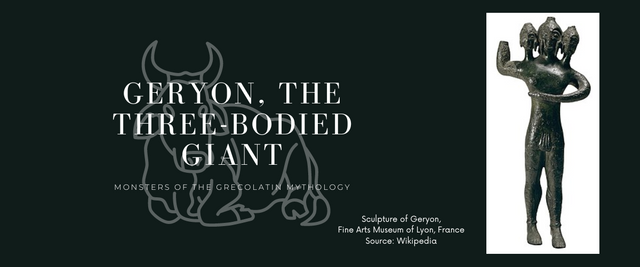Monsters of the Greco - Latin Mythology: Geryon, the three-bodied giant
Author's note: The following article was previously published in Spanish language in my Blurt Blog in January 12th, 2023.  Banner made with Canva. Source of the image: Wikipedia
Banner made with Canva. Source of the image: Wikipedia
Last year, during the last days of October and the whole month of November, a little cycle devoted to the monsters from the Greco-Latin mythology was opened; on it, we talk about the Gorgons and the terrifying Echidna, famous beings for both their mortality when it comes to attacking their enemies. Also were added the Lemuralia and Parentalia, festivities from the Roman world related to Día de Muertos.
However, a new year has begun, and with it the perfect opportunity to go beyond the deities. For that reason, it was decided to retake thebrief cycle that have been left in November, extending it to the beings of the Greco-Latin world who have resisted the passage of time through oral tradition and literature. And what a better character to reinaugurate this cycle than Geryon, the three-bodied giant, the one whom Heracles fought in singular battle during one of his twelve labors.
Who was Geryon?
Known also as Geryone, he was a giant who He was a giant who lived on the island of Erytheia, currently the island of León in Spain. Regarding his appearance, some versions compiled by H. Aubert (1961) and Robert Graves (1985) indicate that he had the particularity of having three heads, six arms and three bodies joined at the waist. Other versions compiled by Manfred Lurker (1998) and Pierre Grimal (1981) indicate that he had three heads and three bodies.
On regard of his origins, Constantino Falcón Martínez, Emilio Fernández-Galiano y Raquel López Melero (1989) mention that Geryon was the son of the Oceanid Callirrhoe and Chrysaor, the warrior of the golden sword. On the paternal side, he was the grandson of Poseidon, god of the seas, and the gorgon Medusa; on the maternal side, he was the grandson of the Titans Oceanus and Tethys. He was the nephew of the Pegasus, since both it and Chrysaor were born from the blood of Medusa.
The myth mentions that he owned a vast herd of reddish-skinned oxen, which he grazed with the help of Orthro, the 2-headed dog, and the shepherd Eurytion. A curious version compiled by Juan Humbert (1962) indicates that Geryon was a sovereign of Baetica, currently the region of Andalusia. For his part, Graves (1985) explains that he was king of Tartessos, a region currently made up of the Spanish provinces of Huelva, Seville and Cádiz. This same author even mentions that he was the father of Erytheia, or Eriteide, one of the consorts of the god Hermes and mother of king Norax of Tartessos.
The theft of the cattle
As part of the twelve works that he had to do to atone for his guilt for the murder of his wife and children, Heracles traveled to Erytheia. According to Andrea Imaginario (n/d), the objective of that task was to steal Geryon's flock and deliver it to king Eurystheus of Argolis.
To achieve the mission, he had to kill Eurytion and Orthro first; some versions indicate that Geryon found out about the death of both thanks to Menetus, a shepherd in the service of Hades (Graves, 1985: 166). Furious at that offense, he confronted Heracles, who kills him with his arrows and carries off the cattle. Later, Eurystheus sacrifices the cattle in honor of the goddess Hera.
Consulted bibliography
- Aubert, H. 1961. Diccionario de mitología. Buenos Aires. Editorial Víctor Leró S. R. L.
- “Bética” (n/d), en: Wikipedia. Consulted in January 11th, 2023.
- Graves, Robert. 1985. Los mitos griegos. Tomo II. México. Alianza Editorial. (English version: The Greek Myths: The Complete and Definitive Edition, 2018)
- Grimal, Pierre. 1981. Diccionario de mitología griega y romana. España. Paidós. (English version: The Penguin Dictionary of Classical Mythology, 1992)
- Humbert, Juan. 1962. Mitología griega y romana. Barcelona. Editorial Gustavo Gili.
- Imaginario, Andrea (n/d). “Los 12 trabajos de Hércules y su significado”, in: Cultura Genial. Consulted in January 12th, 2023.
- Lurker, Manfred. 1998. Diccionario de dioses y diosas, diablos y demonios. España. Paidós. (English version: The Routledge Dictionary of Gods and Goddesses, Demons and Devils, 2004)
- “Geryon” (n/d), in: Wikipedia. Consulted in January 11th, 2023.
Thank you, friend!


I'm @steem.history, who is steem witness.
Thank you for witnessvoting for me.
please click it!
(Go to https://steemit.com/~witnesses and type fbslo at the bottom of the page)
The weight is reduced because of the lack of Voting Power. If you vote for me as a witness, you can get my little vote.
Thank you so much for the support, @steem.history!